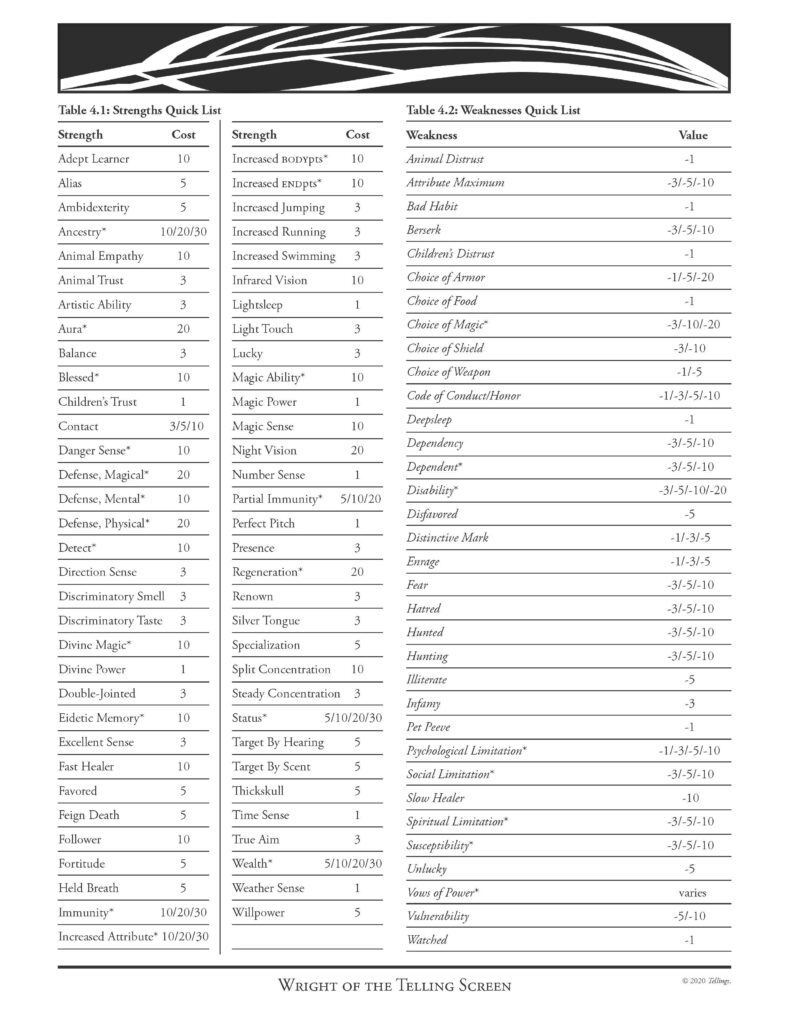
The questions asked at the start of Chapter Two are in part answered by the Strengths and Weaknesses of Chapter Four. This chapter allows the player to delve into the persona of the character to find and develop the character’s likes, dislikes, desires, talents, fears, hatreds, loves, virtues, faults, and other personal idiosyncrasies. Tellings offers a list of over 60 Strengths and over 30 Weaknesses.
Strengths are helpful, beneficial, or positive qualities and abilities. They are often unusual or exceptional talents, gifts, privileges, or resources the character possesses. For example, Strengths range from Ambidexterity to Artistic Ability to being Blessed by a deity to having Excellent Hearing to Fast Healer to Silver Tongue to possessing Wealth. Strengths are physical, mental, spiritual, material, or cultural benefits that give the character an advantage over others.
Weaknesses are traits, beliefs, qualities, or limitations that at times may put the character at a disadvantage or may bring negative reactions or results to the character. A Weakness does not necessarily mean something wicked, or terrible. For example, the Weakness Steadfast means the character does not run from a fight—a quality usually admired—but, in the wrong situation, this Weakness could spell trouble for the character and others. Weaknesses can mean a character is Arrogant or has a Fear or is Good Hearted or has a Pet Peeve or is Superstitious or Unlucky. Weaknesses are physical, mental, spiritual, material, or social disadvantages that limit the character’s actions and access to power and resources.
Strengths and Weaknesses help balance the character’s muscle, mind, and soul as well as their skills, talents, and personality. Strengths and Weaknesses are colorful things, awkward things, and unique things about the character. Strengths and Weaknesses add warmth to the blood, lilt to the voice, shape to a gesture, and thought to the whole of the character.
Remember that certain Strengths and Weaknesses may affect Attributes, Skills, and other character choices and decisions. For example, the Strength Increased Attribute allows the player to increase the value of one of the character’s ATTR scores. Or, for example, the Weakness Choice of Weapon limits the number and kind of Weapon Proficiencies the character can have. Continue to look back at the whole of character creation and allow for revision.
Choosing Strengths and Weaknesses
Like choosing skills, make a wish list of Strengths and a tentative list of Weaknesses. Record the point values for each. Strengths are listed with a positive value. Weaknesses are assigned negative values. The more Weaknesses a character possesses, the more interesting their personality and background becomes and the more points the player has to spend on additional skills and Strengths.
A starting character can have up to -70 Weakness points. Like the starting points allotted to attr, the Wright may increase or decrease the number of Weakness points a character can have depending on the difficulty and nature of the adventure—less points for less-heroic characters (around -50 to -60) and more points for high-powered characters (around -80 to -100).
Strengths can only be bought by taking on Weaknesses. The starting skill points (figured from kno) cannot be used to buy Strengths. For example, the player wishes the character to have +30 points of Strengths. Therefore, the character must have at least -30 points of Weaknesses. The Strengths can only be balanced out by the Weaknesses. Generally, a character should only spend half of their possible Weakness points on Strengths. Furthermore, the Wright may limit the character’s total number of supernatural Strengths a character can possess (e.g. Aura, Divine Magic, Immunity, Magic Ability, Regeneration).
The player may take on more Weaknesses than Strengths to gain additional points to spend on buying skills.
For example, the player buys +30 points of Strengths but chooses to have -70 points of Weaknesses. Therefore, the player has in excess -40 points of disadvantages. The player can then buy up to +40 points of additional skills. A good guideline to follow is that a character should spend up to half their points on Strengths and the remaining majority of points on skills and knowledges. A well-rounded character should have both Strengths and Weaknesses and the advantages and disadvantages should cover a wide spectrum. However, a character should not have too many Strengths and Weaknesses. A curated, considered personality is the goal. A character should not have contradictory Strengths and Weaknesses. Lastly, a Weakness that never comes into play is not a valid Weakness. All of the character’s points should balance out. Use the following formula to determine if the character’s points add up:
Skills + Strengths – |Weaknesses| – (KNO x 3) – xp = 0
The Wright should approve of what Strengths and Weaknesses are be taken by starting characters. Some Strengths and Weaknesses cannot be taken by starting or zero-experience characters. Some Strengths and Weaknesses can be bought multiple times. The Wright must determine the number of bonuses a character can gain; see Chapter Nine for details on bonuses and levels of experience.
The Weakness List

